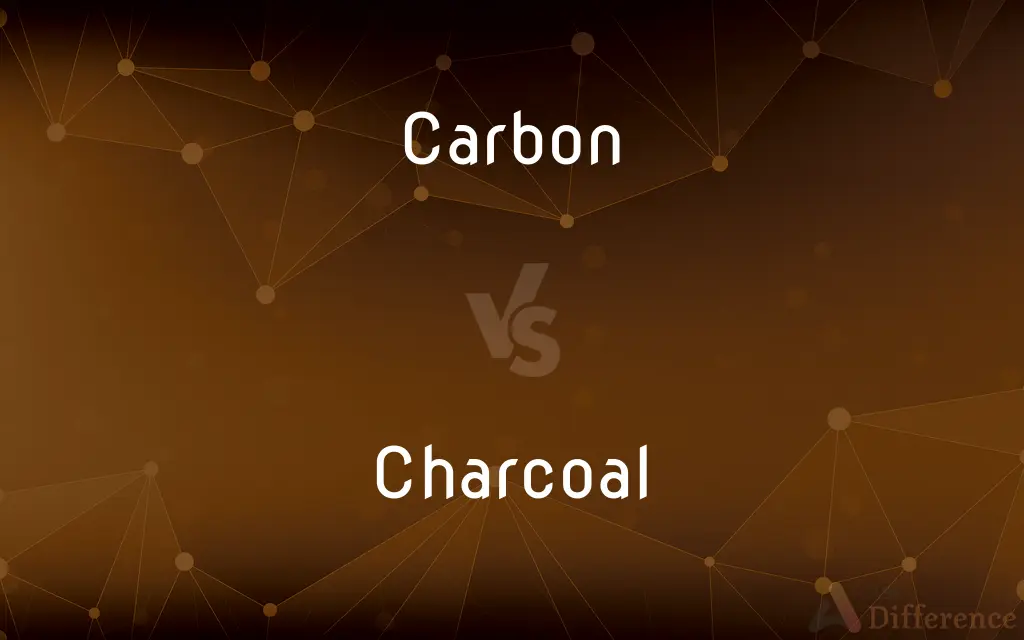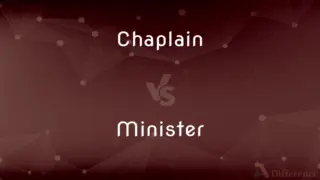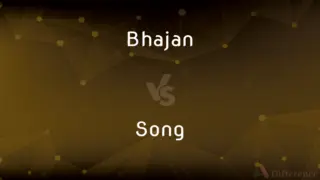Carbon vs. Charcoal — What's the Difference?
Edited by Tayyaba Rehman — By Fiza Rafique — Updated on March 4, 2024
Carbon is a fundamental element, while charcoal is a substance made from carbon-rich materials.

Difference Between Carbon and Charcoal
Table of Contents
ADVERTISEMENT
Key Differences
Carbon, a chemical element with symbol C and atomic number 6, is nonmetallic and tetravalent—making four electrons available to form covalent chemical bonds. Charcoal, on the other hand, is a lightweight black carbon residue produced by removing water and other volatile constituents from plant materials.
Carbon exists in various allotropes, including graphite, diamond, and amorphous carbon, each exhibiting unique properties. Charcoal is made through the process of pyrolysis, which involves heating organic materials in the absence of oxygen.
Carbon forms the basis of all known life on Earth and is the fourth most abundant element in the universe by mass. Charcoal has been used historically as a fuel for heating and cooking, in metal production as a reducing agent, and in modern times, it is utilized for water purification and in air filters due to its ability to absorb impurities.
Carbon is notable for its ability to form a vast number of compounds; in fact, there are nearly ten million carbon-based compounds known to science, highlighting its incredible versatility and importance in chemistry. Charcol porous nature makes it effective in trapping chemicals, preventing their absorption.
Comparison Chart
Nature
Element
Compound/Residue
ADVERTISEMENT
Form
Exists in various allotropes
Porous black solid
Production
Naturally occurring or synthetic
Produced by pyrolysis of organic material
Uses
Wide-ranging: from materials science to life forms
Fuel, reducing agent, filtration
Absorption
Varies by allotrope
High absorption capacity
Compare with Definitions
Carbon
An allotrope of carbon, a good conductor of electricity, used in pencils and as a lubricant.
Graphite's layered structure makes it ideal for pencil leads.
Charcoal
Charcoal that has been heated or otherwise treated to increase its adsorptive power.
Activated charcoal is used in water filters to remove impurities.
Carbon
A chemical element with symbol C and atomic number 6, known for its allotropes, including diamond and graphite.
Carbon compounds are the basis of all known life.
Charcoal
A porous black solid, obtained as a residue when wood, bone, or other organic matter is heated in the absence of oxygen.
Charcoal is widely used for cooking in barbecues.
Carbon
Another allotrope of carbon, the hardest known natural material, used in jewelry and cutting tools.
Diamonds are prized for their unparalleled hardness and brilliance.
Charcoal
A form of charcoal produced from plant matter and stored in the soil as a means of removing carbon dioxide from the atmosphere.
Biochar is recognized for its ability to enhance soil fertility and sequester carbon.
Carbon
A strong, lightweight material made of thin strands of carbon, used in high-performance structures.
Carbon fiber is used in aerospace and sports equipment for its strength-to-weight ratio.
Charcoal
A compressed block of coal dust or charcoal, used for fuel and kindling.
Charcoal briquettes are popular for outdoor grilling due to their consistent heat.
Carbon
A colorless gas produced by burning carbon and organic compounds and by respiration.
Carbon dioxide is a critical greenhouse gas, influencing Earth's climate.
Charcoal
Artistic work made using charcoal as the medium, known for its rich blacks and shading.
Charcoal drawings are valued for their depth and texture.
Carbon
Carbon (from Latin: carbo "coal") is a chemical element with the symbol C and atomic number 6. It is nonmetallic and tetravalent—making four electrons available to form covalent chemical bonds.
Charcoal
Charcoal is a lightweight black carbon residue produced by strongly heating wood (or other animal and plant materials) in minimal oxygen to remove all water and volatile constituents. In the traditional version of this pyrolysis process, called charcoal burning, the heat is supplied by burning part of the starting material itself, with a limited supply of oxygen.
Carbon
The chemical element of atomic number 6, a non-metal which has two main forms (diamond and graphite) and which also occurs in impure form in charcoal, soot, and coal.
Charcoal
A porous black solid, consisting of an amorphous form of carbon, obtained as a residue when wood, bone, or other organic matter is heated in the absence of air.
Carbon
Carbon dioxide or other gaseous carbon compounds released into the atmosphere, associated with climate change
Fossil fuel consumption and carbon emissions continued to rise
The level of carbon in the atmosphere has been consistently rising
Charcoal
A carbonaceous material obtained by heating wood or other organic matter in the absence of air
Carbon
A carbon-containing gas, notably carbon dioxide, or a collection of such gases, especially when considered as a contributor to the greenhouse effect
Plans for capturing and sequestering carbon produced by power plants.
Charcoal
A drawing made with charcoal
Common Curiosities
How is charcoal made?
Charcoal is produced by the pyrolysis of wood, bones, or other organic materials in the absence of oxygen.
Why is carbon important for life?
Carbon atoms can form stable bonds with many elements, including themselves, creating the complex molecules necessary for life.
What is the difference between charcoal and activated charcoal?
Activated charcoal has been treated to increase its adsorptive capacity compared to regular charcoal.
Can all types of carbon conduct electricity?
Graphite, an allotrope of carbon, conducts electricity, while diamond does not.
Can charcoal filter water?
Yes, activated charcoal can absorb impurities and is used in water filtration systems.
Is carbon a solid, liquid, or gas?
Carbon is primarily found in solid forms, such as graphite and diamond, but can also bond with other elements to form gases.
What is carbon?
Carbon is a fundamental chemical element that forms more compounds than all other elements combined.
What are the main uses of charcoal?
Charcoal is used for cooking, metal production, water purification, and air filtration.
What are the different forms of carbon?
Carbon exists in several forms, including diamond, graphite, and amorphous carbon.
Is diamond made entirely of carbon?
Yes, diamond is an allotrope of carbon, consisting purely of carbon atoms arranged in a crystal lattice.
How does charcoal purify air?
Charcoal adsorbs odors and pollutants, trapping them in its porous surface.
What is the environmental impact of charcoal production?
Traditional charcoal production can lead to deforestation and release carbon dioxide; however, sustainable practices aim to minimize these effects.
How long has charcoal been used by humans?
Charcoal has been used since ancient times for drawing, cooking, and as a fuel source.
Can charcoal be reused or recycled?
Charcoal can be reused in certain conditions, but its adsorptive qualities diminish over time, making recycling challenging.
How is biochar used in agriculture?
Biochar is added to soil to improve nutrient retention and reduce carbon dioxide levels in the atmosphere.
Share Your Discovery

Previous Comparison
Chaplain vs. Minister
Next Comparison
Bhajan vs. SongAuthor Spotlight
Written by
Fiza RafiqueFiza Rafique is a skilled content writer at AskDifference.com, where she meticulously refines and enhances written pieces. Drawing from her vast editorial expertise, Fiza ensures clarity, accuracy, and precision in every article. Passionate about language, she continually seeks to elevate the quality of content for readers worldwide.
Edited by
Tayyaba RehmanTayyaba Rehman is a distinguished writer, currently serving as a primary contributor to askdifference.com. As a researcher in semantics and etymology, Tayyaba's passion for the complexity of languages and their distinctions has found a perfect home on the platform. Tayyaba delves into the intricacies of language, distinguishing between commonly confused words and phrases, thereby providing clarity for readers worldwide.














































